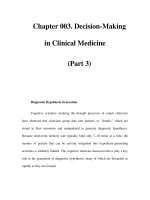Chapter 064. The Practice of Genetics in Clinical Medicine (Part 2) pptx
Bạn đang xem bản rút gọn của tài liệu. Xem và tải ngay bản đầy đủ của tài liệu tại đây (48.93 KB, 5 trang )
Chapter 064. The Practice of Genetics
in Clinical Medicine
(Part 2)
Population Screening
Mass genetic screening programs require tests of high enough sensitivity
and specificity to be cost-effective. An effective screening program should fulfill
the following criteria: that the tested disorder is prevalent and serious; that it can
be influenced presymptomatically through lifestyle changes, screening, or
medications; and that identification of risk does not result in undue discrimination
or harm. Screening individuals of Jewish descent for the autosomal recessive
neurodegenerative disorder Tay-Sachs disease has resulted in a dramatic decline in
the incidence of this syndrome in the United States. On the other hand, screening
for sickle cell disease or trait in the African-American population has sometimes
resulted in insurance and employment discrimination.
Mass screening for complex genetic disorders can result in potential
problems. For example, cystic fibrosis is most commonly associated with
alterations in ∆F508. This variant accounts for 30–80% of mutant alleles
depending on the ethnic group. Nevertheless, cystic fibrosis is associated with
pronounced genetic heterogeneity with more than 1000 disease-related mutations.
The American College of Medical Genetics recommends a panel of 23 alleles,
including the ∆F508 allele, for routine diagnostic and carrier testing. Analysis for
the less common cystic fibrosis–associated mutations would greatly impact the
cost of testing without significantly influencing the effectiveness of mass
screening. Nevertheless, the individual who carries one of the less common cystic
fibrosis–associated alterations will not benefit if testing is limited to a routine
panel.
Occupational health screening programs hold promise but also raise
concerns about employment discrimination. These concerns were brought to light
in 2001 when it was discovered that a railroad company was testing its employees,
without consent, for a rare genetic condition that results in susceptibility to carpal
tunnel syndrome. The Equal Employment Opportunity Commission argued that
the tests were unlawful under the Americans with Disabilities Act.
The Family History
When two or more first-degree relatives are affected with asthma,
cardiovascular disease, type 2 diabetes, breast cancer, colon cancer, or melanoma,
the relative risk ranges from two- to fivefold, underscoring the importance of
family history for these prevalent disorders. Pending further advances in genetic
testing, the key to assessing the inherited risk for common adult-onset diseases
rests in the collection and interpretation of a detailed personal and family medical
history in conjunction with a directed physical examination. For example, a
history of multiple family members with early-onset coronary artery disease,
glucose intolerance, and hypertension should suggest increased risk for genetic,
and perhaps environmental, predisposition to metabolic syndrome (Chap. 236).
Individual patients with this family history should be monitored for the possible
development of hypertension, diabetes, and hyperlipidemia. They should be
counseled about the importance of avoiding additional risk factors such as obesity
and cigarette smoking.
Family history should be recorded in the form of a pedigree. At a
minimum, pedigrees should convey health-related data on all first-degree relatives
and selected second-degree relatives, including grandparents. When pedigrees
appear to suggest an inherited disease, they should be extended to include
additional family members. The determination of risk for an asymptomatic
individual will vary depending on the size of the pedigree, the number of
unaffected relatives, and the types of diagnoses, as well as the ages of disease
onset within the family. For example, a woman with two first-degree relatives with
breast cancer is at greater risk for a Mendelian disorder if she has a total of three
female first-degree relatives than if she has a total of ten female first-degree
relatives. Additional variables that should be documented in the pedigree include
the presence or absence of nonhereditary risk factors among those affected with
diseases, and the finding of multiple diseases in an individual patient. For instance,
a woman with a history of both colon cancer and endometrial cancer is at risk for
hereditary nonpolyposis colon cancer (HNPCC) regardless of her family history.
When assessing the personal and family history, the physician should be
alert to a younger age of disease onset than is usually seen in the general
population. A 30-year-old with acute myocardial infarction should be considered
at risk for a hereditary trait, even if there is no family history of premature
coronary artery disease (Chap. 235). The absence of the nonhereditary risk factors
typically associated with a disease also raises the prospect of genetic causation. A
personal or family history of deep-vein thrombosis, in the absence of known
environmental or medical risk factors, suggests a hereditary thrombotic disorder
(Chap. 111). The physical examination also may provide important clues about the
risk for a specific inherited disorder. A patient presenting with xanthomas at a
young age should prompt consideration of familial hypercholesterolemia. Some
adult-onset disease-causing mutations are more prevalent in certain ethnic groups.
For instance, >2% of the Ashkenazi population carry one of three specific
mutations in the BRCA1 or BRCA2 genes. The prevalence of the factor V Leiden
allele ranges from 3 to 7% in Caucasians but is much lower in Africans or Asians.









